转载请务必注明出处,原创不易!
相关文章:通过项目逐步深入了解Mybatis<一>
本项目全部代码地址:Github-Mybatis
Mybatis 解决 jdbc 编程的问题
1、 数据库链接创建、释放频繁造成系统资源浪费从而影响系统性能,如果使用数据库链接池可解决此问题。
解决:在SqlMapConfig.xml中配置数据链接池,使用连接池管理数据库链接。
2、 Sql语句写在代码中造成代码不易维护,实际应用sql变化的可能较大,sql变动需要改变java代码。
解决:将Sql语句配置在XXXXmapper.xml文件中与java代码分离。
3、 向sql语句传参数麻烦,因为sql语句的where条件不一定,可能多也可能少,占位符需要和参数一一对应。
解决:Mybatis自动将java对象映射至sql语句,通过statement中的parameterType定义输入参数的类型。
4、 对结果集解析麻烦,sql变化导致解析代码变化,且解析前需要遍历,如果能将数据库记录封装成pojo对象解析比较方便。
解决:Mybatis自动将sql执行结果映射至java对象,通过statement中的resultType定义输出结果的类型。
Mybatis 与 Hibernate 不同
Mybatis和hibernate不同,它不完全是一个ORM框架,因为MyBatis需要程序员自己编写Sql语句,不过mybatis可以通过XML或注解方式灵活配置要运行的sql语句,并将java对象和sql语句映射生成最终执行的sql,最后将sql执行的结果再映射生成java对象。
Mybatis学习门槛低,简单易学,程序员直接编写原生态sql,可严格控制sql执行性能,灵活度高,非常适合对关系数据模型要求不高的软件开发,例如互联网软件、企业运营类软件等,因为这类软件需求变化频繁,一但需求变化要求成果输出迅速。但是灵活的前提是mybatis无法做到数据库无关性,如果需要实现支持多种数据库的软件则需要自定义多套sql映射文件,工作量大。
Hibernate对象/关系映射能力强,数据库无关性好,对于关系模型要求高的软件(例如需求固定的定制化软件)如果用hibernate开发可以节省很多代码,提高效率。但是Hibernate的学习门槛高,要精通门槛更高,而且怎么设计O/R映射,在性能和对象模型之间如何权衡,以及怎样用好Hibernate需要具有很强的经验和能力才行。
总之,按照用户的需求在有限的资源环境下只要能做出维护性、扩展性良好的软件架构都是好架构,所以框架只有适合才是最好。
Mybatis 开发 dao
两种方法
- 原始 dao 开发方法(程序需要编写 dao 接口和 dao 实现类)(掌握)
- Mybatis 的 mapper 接口(相当于 dao 接口)代理开发方法(掌握)
需求
将下边的功能实现Dao:
- 根据用户id查询一个用户信息
- 根据用户名称模糊查询用户信息列表
- 添加用户信息
Mybatis 配置文件 SqlMapConfig.xml
Sqlsession 的使用范围
SqlSession 中封装了对数据库的操作,如:查询、插入、更新、删除等。
通过 SqlSessionFactory 创建 SqlSession,而 SqlSessionFactory 是通过 SqlSessionFactoryBuilder 进行创建。
1、SqlSessionFactoryBuilder
SqlSessionFactoryBuilder 用于创建 SqlSessionFacoty,SqlSessionFacoty 一旦创建完成就不需要SqlSessionFactoryBuilder 了,因为 SqlSession 是通过 SqlSessionFactory 生产,所以可以将SqlSessionFactoryBuilder 当成一个工具类使用,最佳使用范围是方法范围即方法体内局部变量。
2、SqlSessionFactory
SqlSessionFactory 是一个接口,接口中定义了 openSession 的不同重载方法,SqlSessionFactory 的最佳使用范围是整个应用运行期间,一旦创建后可以重复使用,通常以单例模式管理 SqlSessionFactory。
3、SqlSession
SqlSession 是一个面向用户的接口, sqlSession 中定义了数据库操作,默认使用 DefaultSqlSession 实现类。
执行过程如下:
1)、 加载数据源等配置信息
Environment environment = configuration.getEnvironment();
2)、 创建数据库链接
3)、 创建事务对象
4)、 创建Executor,SqlSession 所有操作都是通过 Executor 完成,mybatis 源码如下:
1 | if (ExecutorType.BATCH == executorType) { |
5)、 SqlSession的实现类即 DefaultSqlSession,此对象中对操作数据库实质上用的是 Executor
结论:
每个线程都应该有它自己的SqlSession实例。SqlSession的实例不能共享使用,它也是线程不安全的。因此最佳的范围是请求或方法范围(定义局部变量使用)。绝对不能将SqlSession实例的引用放在一个类的静态字段或实例字段中。
打开一个SqlSession;使用完毕就要关闭它。通常把这个关闭操作放到 finally 块中以确保每次都能执行关闭。如下:
1 | SqlSession session = sqlSessionFactory.openSession(); |
原始 Dao 开发方法
思路:
需要程序员编写 Dao 接口和 Dao 实现类;
需要在 Dao 实现类中注入 SqlsessionFactory ,在方法体内通过 SqlsessionFactory 创建 Sqlsession。
Dao接口
1 | public interface UserDao //dao接口,用户管理 |
Dao 实现类
1 | public class UserDaoImpl implements UserDao //dao接口实现类 |
测试
1 | public class UserDaoImplTest |
通过id查询用户信息测试结果如下:(其他的可以自己在写测试代码,原理类似)

问题
原始Dao开发中存在以下问题:
- Dao方法体存在重复代码:通过 SqlSessionFactory 创建 SqlSession,调用 SqlSession 的数据库操作方法
- 调用 sqlSession 的数据库操作方法需要指定 statement 的i d,这里存在硬编码,不得于开发维护。
- 调用 sqlSession 的数据库操作方法时传入的变量,由于 sqlsession 方法使用泛型,即使变量类型传入错误,在编译阶段也不报错,不利于程序员开发。
Mybatis 的 mapper 接口
思路
程序员需要编写 mapper.xml 映射文件
只需要程序员编写Mapper接口(相当于Dao接口),需遵循一些开发规范,mybatis 可以自动生成 mapper 接口类代理对象。
开发规范:
在 mapper.xml 中 namespace 等于 mapper 接口地址
1
<mapper namespace="cn.zhisheng.mybatis.mapper.UserMapper"></mapper>
在 xxxmapper.java 接口中的方法名要与 xxxMapper.xml 中 statement 的 id 一致。
在 xxxmapper.java 接口中的输入参数类型要与 xxxMapper.xml 中 statement 的 parameterType 指定的参数类型一致。
在 xxxmapper.java 接口中的返回值类型要与 xxxMapper.xml 中 statement 的 resultType 指定的类型一致。
UserMapper.java1
2//根据id查询用户信息
public User findUserById(int id) throws Exception;UserMapper.xml1
2
3<select id="findUserById" parameterType="int" resultType="cn.zhisheng.mybatis.po.User">
select * from user where id = #{1}
</select>
总结:
以上的开发规范主要是对下边的代码进行统一的生成:
1 | User user = sqlSession.selectOne("test.findUserById", id); |
测试
测试之前记得在 SqlMapConfig.xml 文件中添加加载映射文件 UserMapper.xml:
1 | <mapper resource="mapper/UserMapper.xml"/> |
测试代码:
1 | public class UserMapperTest |
通过id查询用户信息测试结果如下:(其他的请自己根据上下文写测试代码,或者去看我 Github-Mybatis学习笔记 上看我这个项目的全部代码)

通过姓名查询用户信息:
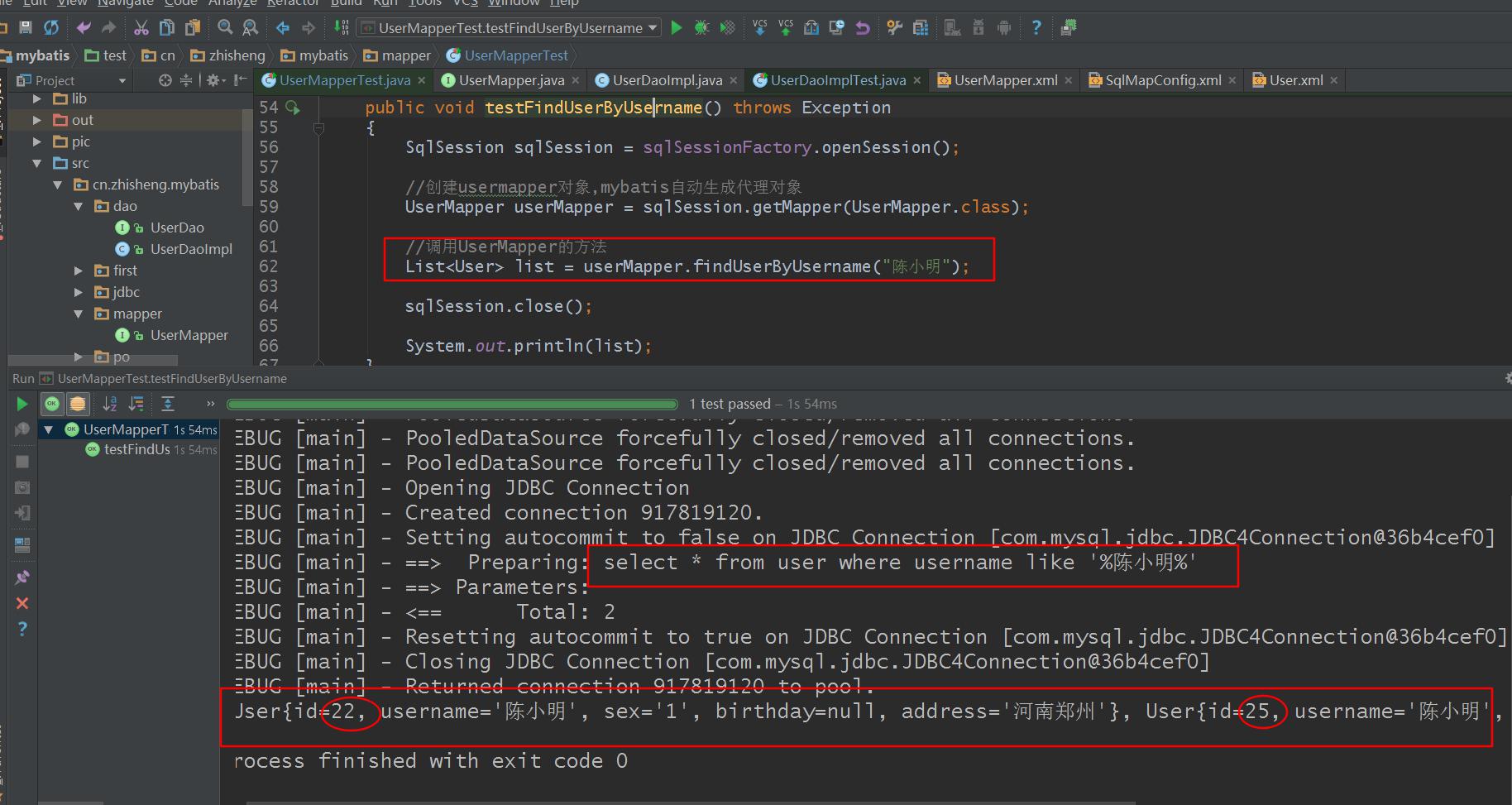
代理对象内部调用 selectOne 或者 selectList
- 如果 mapper 方法返回单个 pojo 对象(非集合对象),代理对象内部通过 selectOne 查询数据库
- 如果 mapper 方法返回集合对象,代理对象内部通过 selectList 查询数据库
mapper接口方法参数只能有一个是否影响系统开发
mapper 接口方法参数只能有一个,系统是否不利于维护?
系统框架中,dao层的代码是被业务层公用的。
即使 mapper 接口只有一个参数,可以使用包装类型的 pojo 满足不同的业务方法的需求。
注意:持久层方法的参数可以包装类型、map…. ,service方法中不建议使用包装类型。(不利于业务层的可扩展性)
SqlMapConfig.xml 文件
Mybatis 的全局配置变量,配置内容和顺序如下:
properties(属性)
settings(全局配置参数)
typeAliases(类型别名)
typeHandlers(类型处理器)
objectFactory(对象工厂)
plugins(插件)
environments(环境集合属性对象)
environment(环境子属性对象)
transactionManager(事务管理)
dataSource(数据源)
mappers(映射器)
properties 属性
需求:将数据库连接参数单独配置在 db.properties 中,只需要在 SqlMapConfig.xml 中加载该配置文件 db.properties 的属性值。在 SqlMapConfig.xml 中就不需要直接对数据库的连接参数进行硬编码了。方便以后对参数进行统一的管理,其他的xml文件可以引用该 db.properties 。
db.properties
1 | jdbc.driver=com.mysql.jdbc.Driver |
那么 SqlMapConfig.xml 中的配置变成如下:
1 | <!--加载配置文件--> |
配置完成后我们测试一下是否能够和刚才一样的能够成功呢?那么我就先在db.properties中把数据库密码故意改错,看是否是正确的?不出意外的话是会报错的。
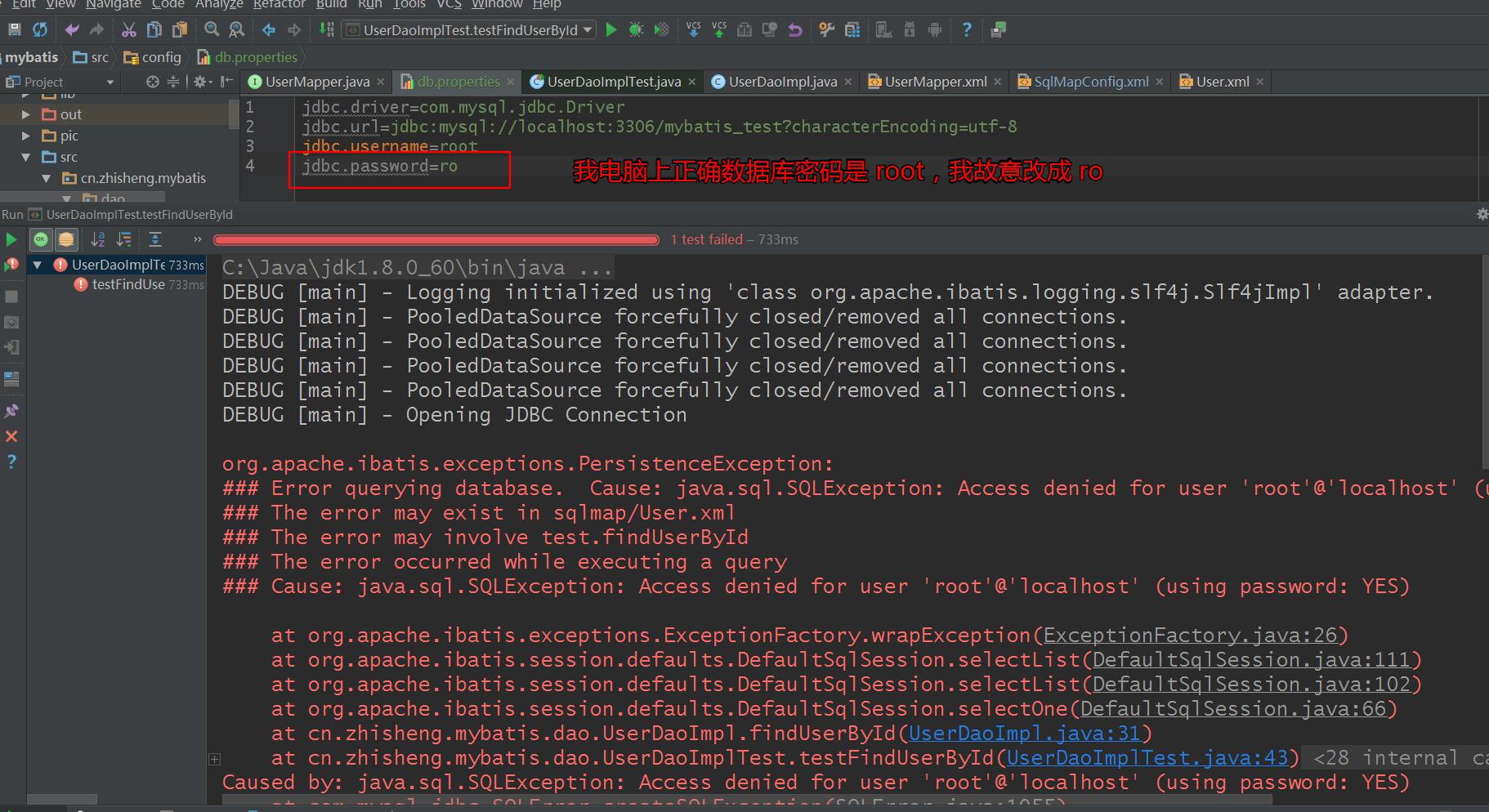
注意: MyBatis 将按照下面的顺序来加载属性:
- 在 properties 元素体内定义的属性首先被读取。
- 然后会读取 properties 元素中 resource 或 url 加载的属性,它会覆盖已读取的同名属性。
最后读取 parameterType 传递的属性,它会覆盖已读取的同名属性。
因此,通过parameterType传递的属性具有最高优先级,resource或 url 加载的属性次之,最低优先级的是 properties 元素体内定义的属性。
建议:
- 不要在 properties 元素体内添加任何属性值,只将属性值定义在 db.properties 文件之中。
- 在 db.properties 文件之中定义的属性名要有一定的特殊性。如 xxx.xxx.xxx
settings(全局配置参数)
Mybatis 框架在运行时可以调整一些运行参数
比如:开启二级缓存、开启延迟加载。。。

typeAliases(类型别名)
需求:
在mapper.xml中,定义很多的statement,statement需要parameterType指定输入参数的类型、需要resultType指定输出结果的映射类型。
如果在指定类型时输入类型全路径,不方便进行开发,可以针对parameterType或resultType指定的类型定义一些别名,在mapper.xml中通过别名定义,方便开发。
Mybatis支持的别名:
| 别名 | 映射的类型 |
|---|---|
| _byte | byte |
| _long | long |
| _short | short |
| _int | int |
| _integer | int |
| _double | double |
| _float | float |
| _boolean | boolean |
| string | String |
| byte | Byte |
| long | Long |
| short | Short |
| int | Integer |
| integer | Integer |
| double | Double |
| float | Float |
| boolean | Boolean |
| date | Date |
| decimal | BigDecimal |
| bigdecimal | BigDecimal |
自定义别名:
在 SqlMapConfig.xml 中配置:(设置别名)
1 | <typeAliases> |
在 UserMapper.xml 中引用别名:( resultType 为 user )
1 | <select id="findUserById" parameterType="int" resultType="user"> |
测试结果:
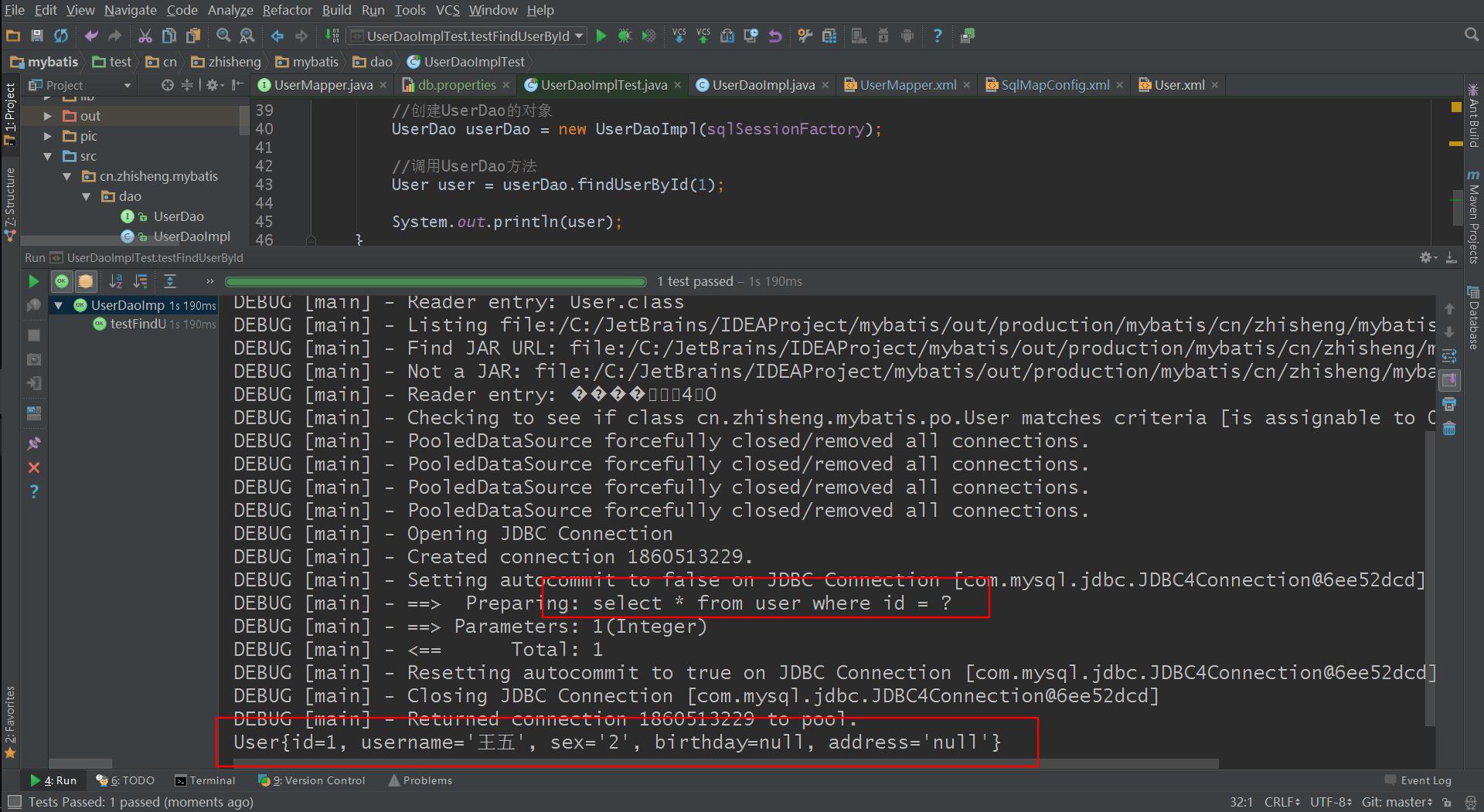
typeHandlers(类型处理器)
mybatis中通过typeHandlers完成jdbc类型和java类型的转换。
通常情况下,mybatis提供的类型处理器满足日常需要,不需要自定义.
mybatis支持类型处理器:
| 类型处理器 | Java类型 | JDBC类型 |
|---|---|---|
| BooleanTypeHandler | Boolean,boolean | 任何兼容的布尔值 |
| ByteTypeHandler | Byte,byte | 任何兼容的数字或字节类型 |
| ShortTypeHandler | Short,short | 任何兼容的数字或短整型 |
| IntegerTypeHandler | Integer,int | 任何兼容的数字和整型 |
| LongTypeHandler | Long,long | 任何兼容的数字或长整型 |
| FloatTypeHandler | Float,float | 任何兼容的数字或单精度浮点型 |
| DoubleTypeHandler | Double,double | 任何兼容的数字或双精度浮点型 |
| BigDecimalTypeHandler | BigDecimal | 任何兼容的数字或十进制小数类型 |
| StringTypeHandler | String | CHAR和VARCHAR类型 |
| ClobTypeHandler | String | CLOB和LONGVARCHAR类型 |
| NStringTypeHandler | String | NVARCHAR和NCHAR类型 |
| NClobTypeHandler | String | NCLOB类型 |
| ByteArrayTypeHandler | byte[] | 任何兼容的字节流类型 |
| BlobTypeHandler | byte[] | BLOB和LONGVARBINARY类型 |
| DateTypeHandler | Date(java.util) | TIMESTAMP类型 |
| DateOnlyTypeHandler | Date(java.util) | DATE类型 |
| TimeOnlyTypeHandler | Date(java.util) | TIME类型 |
| SqlTimestampTypeHandler | Timestamp(java.sql) | TIMESTAMP类型 |
| SqlDateTypeHandler | Date(java.sql) | DATE类型 |
| SqlTimeTypeHandler | Time(java.sql) | TIME类型 |
| ObjectTypeHandler | 任意 | 其他或未指定类型 |
| EnumTypeHandler | Enumeration类型 | VARCHAR-任何兼容的字符串类型,作为代码存储(而不是索引)。 |
mappers(映射器)
使用相对于类路径的资源,如:
使用完全限定路径
如:使用 mapper 接口类路径
如:
注意:此种方法要求 mapper 接口名称和 mapper 映射文件名称相同,且放在同一个目录中。
注册指定包下的所有mapper接口
如:
注意:此种方法要求 mapper 接口名称和 mapper 映射文件名称相同,且放在同一个目录中。
Mapper.xml 映射文件
Mapper.xml映射文件中定义了操作数据库的sql,每个sql是一个statement,映射文件是mybatis的核心。
输入映射
通过 parameterType 指定输入参数的类型,类型可以是简单类型、hashmap、pojo的包装类型。
传递 pojo 包装对象 (重点)
开发中通过pojo传递查询条件 ,查询条件是综合的查询条件,不仅包括用户查询条件还包括其它的查询条件(比如将用户购买商品信息也作为查询条件),这时可以使用包装对象传递输入参数。
定义包装对象
定义包装对象将查询条件(pojo)以类组合的方式包装起来。
UserQueryVo.java1
2
3
4
5
6
7
8
9
10
11
12
13
14
15public class UserQueryVo //用户包装类型
{
//在这里包装所需要的查询条件
//用户查询条件
private UserCustom userCustom;
public UserCustom getUserCustom()
{
return userCustom;
}
public void setUserCustom(UserCustom userCustom)
{
this.userCustom = userCustom;
}
//还可以包装其他的查询条件,比如订单、商品
}UserCustomer.java1
2
3
4public class UserCustom extends User //用户的扩展类
{
//可以扩展用户的信息
}UserMapper.xml文件1
2
3
4
5
6
7<!--用户信息综合查询
#{userCustom.sex} :取出pojo包装对象中的性别值
#{userCustom.username} :取出pojo包装对象中的用户名称
-->
<select id="findUserList" parameterType="cn.zhisheng.mybatis.po.UserQueryVo" resultType="cn.zhisheng.mybatis.po.UserCustom">
select * from user where user.sex = #{userCustom.sex} and user.username like '%${userCustom.username}%'
</select>UserMapper.java
1
2//用户信息综合查询
public List<UserCustom> findUserList(UserQueryVo userQueryVo) throws Exception;测试代码
1
2
3
4
5
6
7
8
9
10
11
12
13
14
15
16
17//测试用户信息综合查询
public void testFindUserList() throws Exception
{
SqlSession sqlSession = sqlSessionFactory.openSession();
//创建usermapper对象,mybatis自动生成代理对象
UserMapper userMapper = sqlSession.getMapper(UserMapper.class);
//创建包装对象,设置查询条件
UserQueryVo userQueryVo = new UserQueryVo();
UserCustom userCustom = new UserCustom();
userCustom.setSex("男");
userCustom.setUsername("张小明");
userQueryVo.setUserCustom(userCustom);
//调用UserMapper的方法
List<UserCustom> list = userMapper.findUserList(userQueryVo);
System.out.println(list);
}测试结果
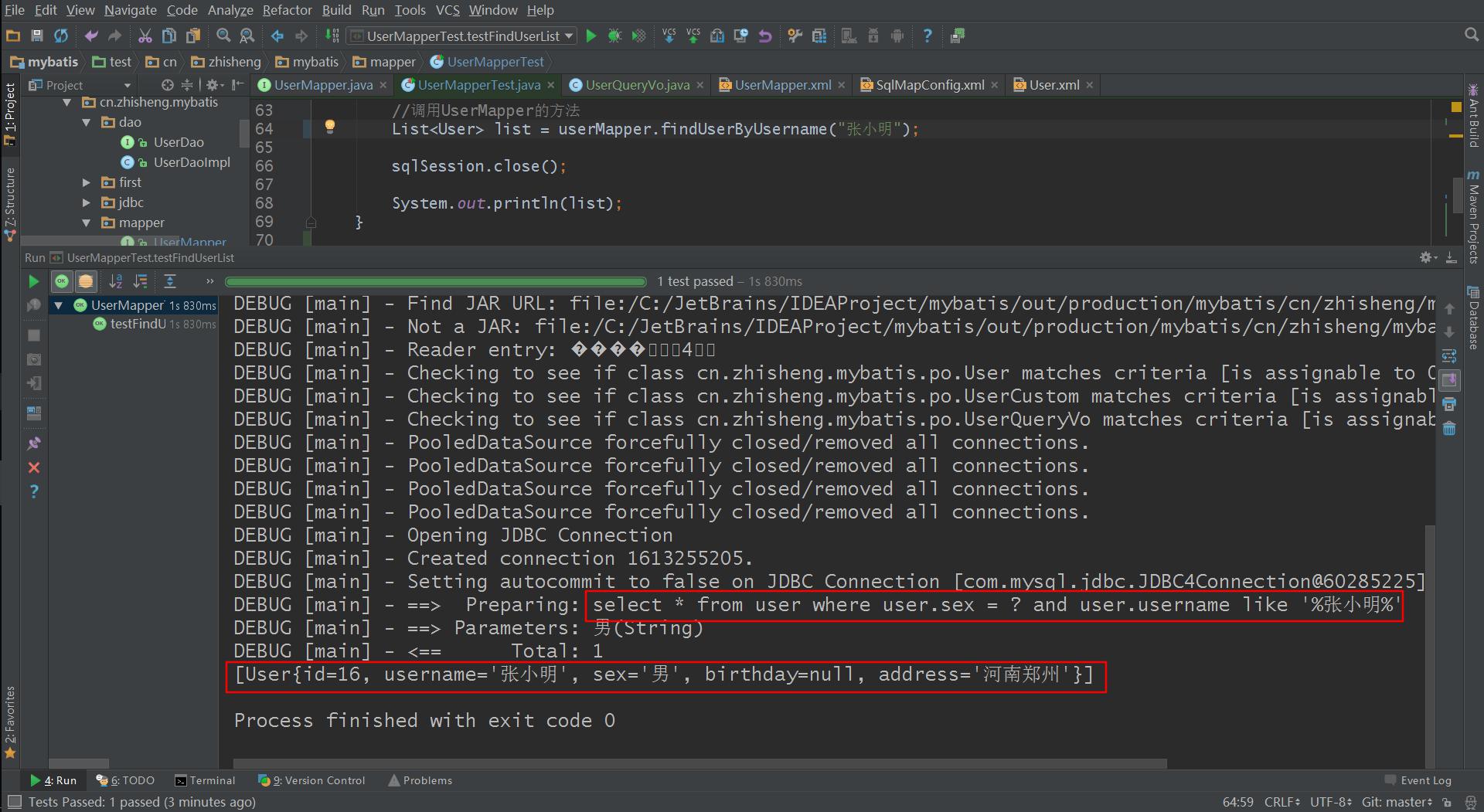
输出映射
- resultType
- 使用 resultType 进行输出映射,只有查询出来的列名和 pojo 中的属性名一致,该列才可以映射成功。
- 如果查询出来的列名和 pojo 中的属性名全部不一致,没有创建 pojo 对象。
- 只要查询出来的列名和 pojo 中的属性有一个一致,就会创建 pojo 对象。
输出简单类型
需求:用户信息综合查询列表总数,通过查询总数和上边用户综合查询列表才可以实现分页
实现:
1 | <!--用户信息综合查询总数 |
1 | //用户信息综合查询总数 |
1 | //测试用户信息综合查询总数 |
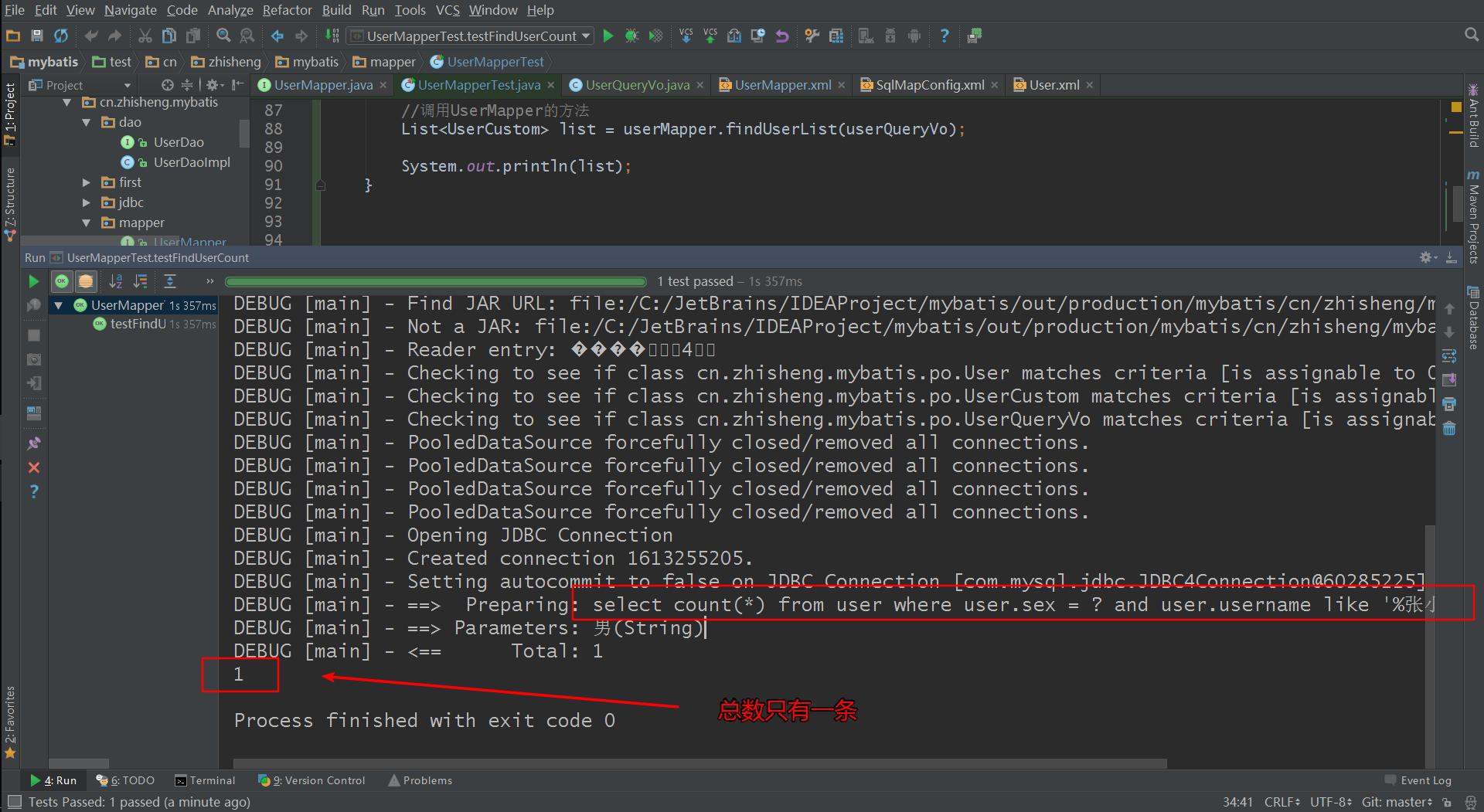
注意:查询出来的结果集只有一行且一列,可以使用简单类型进行输出映射。
输出pojo对象和pojo列表
不管是输出的pojo单个对象还是一个列表(list中包括pojo),在mapper.xml中resultType指定的类型是一样的。
在mapper.java指定的方法返回值类型不一样:
1、输出单个pojo对象,方法返回值是单个对象类型
1 | //根据id查询用户信息 |
2、输出pojo对象list,方法返回值是List
1 | //根据用户名查询用户信息 |
resultType总结:
输出pojo对象和输出pojo列表在sql中定义的resultType是一样的。
返回单个pojo对象要保证sql查询出来的结果集为单条,内部使用session.selectOne方法调用,mapper接口使用pojo对象作为方法返回值。
返回pojo列表表示查询出来的结果集可能为多条,内部使用session.selectList方法,mapper接口使用List
- resultMap
resultType 可以指定 pojo 将查询结果映射为 pojo,但需要 pojo 的属性名和 sql 查询的列名一致方可映射成功。
如果sql查询字段名和pojo的属性名不一致,可以通过resultMap将字段名和属性名作一个对应关系 ,resultMap实质上还需要将查询结果映射到pojo对象中。
resultMap可以实现将查询结果映射为复杂类型的pojo,比如在查询结果映射对象中包括pojo和list实现一对一查询和一对多查询。
使用方法:
1、定义 resultMap
2、使用 resultMap 作为 statement 的输出映射类型
将下面的 sql 使用 User 完成映射
1 | select id id_, username username_ from user where id = #{value} |
User 类中属性名和上边查询的列名不一致。
所以需要:
1、定义 resultMap
1 | <!--定义 resultMap |
2、使用 resultMap 作为 statement 的输出映射类型
1 | <!--使用 resultMap 作为输出映射类型 |
3、UserMapper.java
1 | //根据id查询用户信息,使用 resultMap 输出 |
4、测试
1 | //测试根据id查询用户信息,使用 resultMap 输出 |
5、测试结果
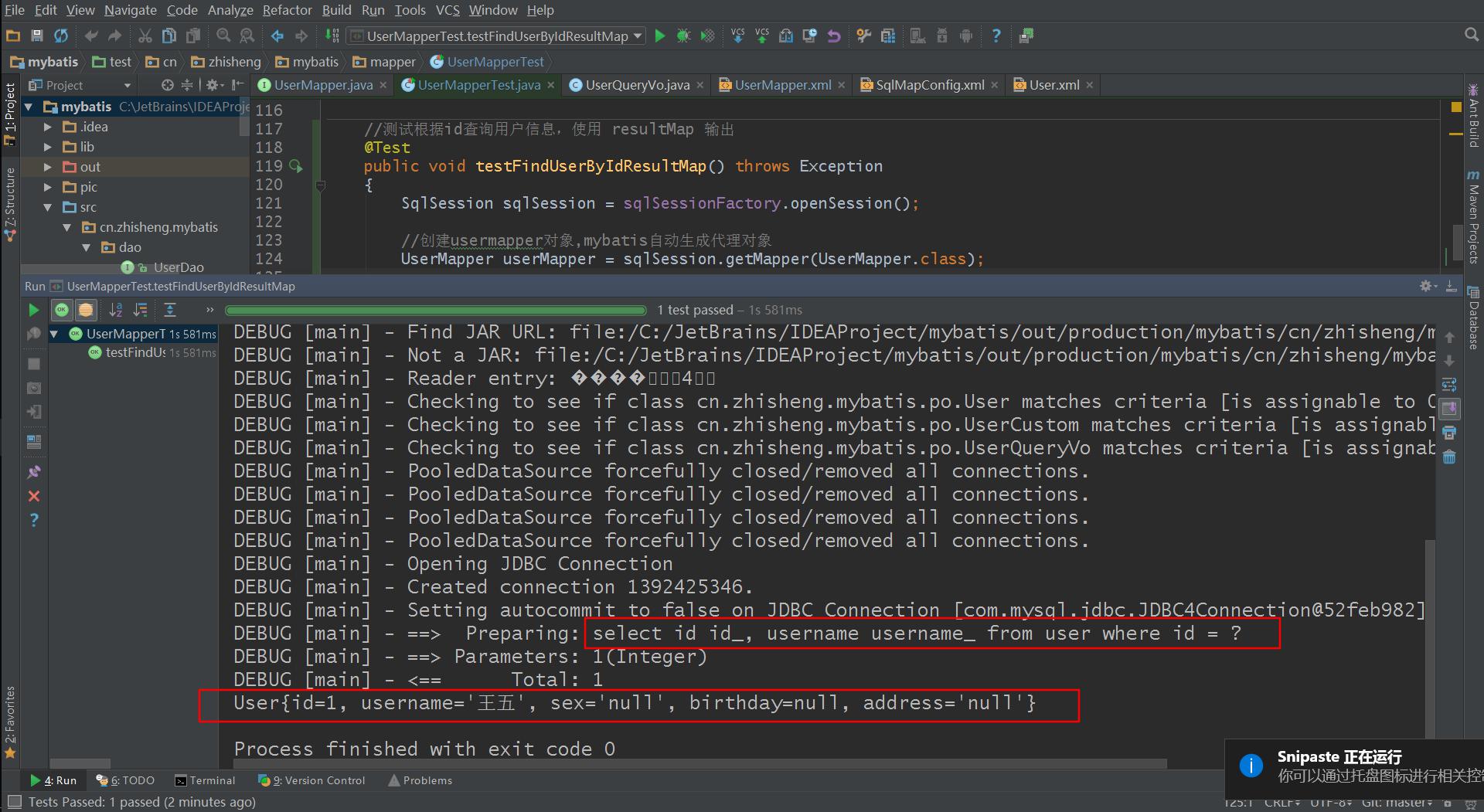
动态 SQL
通过mybatis提供的各种标签方法实现动态拼接sql。
需求:
用户信息综合查询列表和用户信息查询列表总数这两个 statement的定义使用动态sql。
对查询条件进行判断,如果输入的参数不为空才进行查询条件拼接。
UserMapper.xml (findUserList的配置如下,那么findUserCount的也是一样的,这里就不全部写出来了)
1 | <select id="findUserList" parameterType="cn.zhisheng.mybatis.po.UserQueryVo" resultType="cn.zhisheng.mybatis.po.UserCustom"> |
测试代码:因为设置了动态的sql,如果不设置某个值,那么条件就不会拼接在sql上
所以我们就注释掉设置username的语句
1 | //userCustom.setUsername("张小明"); |
测试结果:

Sql 片段
通过上面的其实看到在 where sql语句中有很多重复代码,我们可以将其抽取出来,组成一个sql片段,其他的statement就可以引用这个sql片段,利于系统的开发。
这里我们就拿上边sql 中的where定义一个sq片段如下:
1 | <!--sql片段 |
那么我们该怎样引用这个sql片段呢?如下:
1 | select * from user |
测试的话还是那样了,就不继续说了,前面已经说了很多了。
foreach
向sql传递数组或List,mybatis使用foreach解析
需求:
在用户查询列表和查询总数的statement中增加多个id输入查询。
sql语句如下:
1 | SELECT * FROM USER WHERE id=1 OR id=10 ORid=16 |
在输入参数类型中添加 List
1 | public class UserQueryVo //用户包装类型 |
修改 UserMapper.xml文件
WHERE id=1 OR id=10 OR id=16
在查询条件中,查询条件定义成一个sql片段,需要修改sql片段。
1 | <if test="ids!=null"> |
测试代码:
1 | //传入多个id |
期待后续的文章吧!




